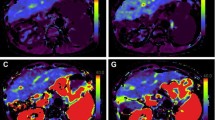Abstract
In patients with liver cirrhosis a transjugularly placed intrahepatic portocaval shunt (TIPS) is a non-surgical portosystemic device which aims to reduce portal venons pressure. In comparison with Doppler sonography, we evaluated in 28 patients the diagnostic impact of liver perfusion scintigraphy (with technetium-99m diethylene triamine penta-acetic acid) in the assessment of changes in the hepatic blood flow after TIPS shunting. The arterial and portal contributions to hepatic flow were calculated from the areas under the biphasic timeactivity curve. In the course of TIPS shunting, patency is threatened by reocclusion. Angiography is the gold standard for TIPS shunt reassessment. However, there is a need for a less invasive diagnostic procedure, such as scintigraphy or Doppler sonography, for the early detection of shunt insufficiency. Scintigraphy demonstrated that prior to TIPS shunting the portal venons contribution to hepatic perfusion was reduced to 29.2%, this reduction being due to portal hypertension. After TIPS placement a significant increase in portal venous perfusion was observed (38.2%;P<0.02). TIPS shunt occlusion was identified in patients by a significant reduction in the scintigraphically measured portal venons contribution to hepatic blood flow. Hepatic perfusion scintigraphy appears to be a valuable method to determine the immediate effect of TIPS on hepatic blood flow. Post-TIPS follow-up studies of hepatic haemodynamics by liver perfusion scintigraphy appear able to contribute to the detection of TIPS shunt occlusion before the clinical consequences of this complication have become apparent.
Similar content being viewed by others
References
van Leeuwen DJ. Assessment of portal hypertension: understanding will improve treatment.Dig Dis 1991; 9: 92–105.
Brewer TG. Treatment of acute gastroesophageal variceal hemorrhage.Med Clin North Am 1993; 77: 993–1014.
Navasa M, Garcia Pagan JC, Bosch J, Riera JR, Banares R, Mas A, Bruguera M, Rodes J. Portal hypertension in acute liver failure.Gut 1992; 33: 965–968.
McCormick PA, Jenkins SA, McIntyre N, Burroughs AK. Why portal hypertensive varices bleed and bleed: a hypothesis.Gut 1995; 36: 100–103.
Rossle M, Richter GM, Noldge G, Palmaz JC, Wenz W, Gerok W. New non-operative treatment for variceal haemorrhage [letter].Lancet 1989; II: 153.
Chong WK, Malisch TA, Mazer MJ, Lind CD, Worrell JA, Richards WO. Transjugular intrahepatic portosystemic shunt: US assessment with maximum flow velocity.Radiology 1993; 189 789–793.
Ferral H, Foshager MC, Bjarnason H, Finlay DE, Hunter DW, Castaneda Zuniga WR, Letourneau JG. Early sonographic evaluation of the transjugular intrahepatic portosystemic shunt (TIPS).ardiovasc Intervent Radiol 1993; 16: 275–279.
Talavera A, Artaza T, Gómez R, Legaz ML, Garciá L. Usefulness of Doppler sonography in monitoring transjugular intrahepatic portosystemic shunts.J Clin Ultrasound 1994; 22: 137–140.
Dodd GD, Zajko AB, Orons PD, Martin MS, Eichner LS, Santaguida LA. Detection of transjugular intrahepatic portosystemic shunt dysfunction: value of duplex Doppler sonography.AJR 1995; 164: 1119–1124.
Foshager MC, Ferral H, Nazarian GK, Castaneda Zuniga WR, Letourneau JG. Duplex sonography after transjugular intrahepatic portosystemic shunts (TIPS): normal hemodynamic findings and efficacy in predicting shunt patency and stenosis.AJR 1995; 165: 1–7.
Taplin GV. Dynamic studies of liver function with radioisotopes. In:Dynamic studies wich radioisotopes in medicine. New York: Unipub; 1971: 373–392.
Biersack HJ, Thelen M, Schulz D, Knopp R, Dahlem R, Schmidt R, Winkler C. Die sequentielle Hepatospleno-Szintigraphie zur quantitativen Beurteilung der Leberdurchblutung.Fortschr Röntgenstr 1977; 126: 47–52.
Biersack HJ, Torres J, Thelen M, Molon O, Winkler C. Determination of liver and spleen perfusion by quantitative sequential scintigraphy: results in normal subjects and in patients with portal hypertension.Clin Nucl Med 1981; 6: 218–220.
Rössle M, Haag K, Ochs A, Sellinger M, Nöldge G, Perarnau J-M, Berger E, Blum U, Gabelmann A, Hauenstein K, Langer M, Gerok W. The transjugular intrahepatic portosystemic stent-shunt procedure for variceal bleeding.N Engl J Med 1994; 330: 165–171.
Richter GM, Roeren T, Roessle M, Palmaz JC. Transjugular intrahepatic portosystemic stent shunt.Baillieres Clin Gastroenterol 1992; 6: 403–419.
Biersack HL. Die quantitative Leberperfusionsszintigraphie.Langenbecks Arch Chir 1980; 351: 23–37.
Martin-Comin J, Mora J, Figueras J, Puchal R, Jaurrita E, Badosa F, Ramos M. Calculation of portal contribution to hepatic blood flow with 99m-Tc-microcolloids: a non-invasive method to diagnose liver graft rejection.J Nucl Med 1988; 29: 1776–1780.
Breslow NA. A generalized Kruskal-Wallis test for comparing K samples subject to unequal patterns of censorship.Biometrika 1970; 57: 579–594.
Burn P, Taylor K, Blei AT. Doppler flowmetry and portal hypertension.Gastroenterology 1987; 92: 824–846.
Bolondi L, Gaiani S, Barbara L. Accuracy and reproducibility of portal flow measurement by Doppler US.J Hepatol 1991; 13:269–273.
Miller J, Diftey BL, Fleming JS. Measurement of colloid clearance rate as an adjunet to static liver imaging.Eur J Nucl Med 1979, 4: 1–5.
Leng B, O'Driscoll MP, Majeed FA, Grime JS, Critchley M. Hepatic perfusion index in cirrhotic livers - investigation of imaging and analytical procedures.Nucl Med Commun 1987; 8:1001–1010.
Viallet A, Marleau D, Huet M, Martin F, Farley A, Villeneuve J-P, Lavoie P. Haemodynamic evaluation of patients with intrahepatic portal hypertension.Gastroenterology 1975; 69: 1297–1300.
Meng HC, Lin HC, Tsai YT, et al. Relationships between the severity of cirrhosis and haemodynamic values in patients with cirrhosis.J Gastroenterol Hepatol 1994; 9: 148–153.
Sweeting JG. Tips: good for the liver, but what about the heart?Gastroenterology 1994; 107: 593–594.
Wong F, Sniderman K, Liu P, Allidina Y, Sherman M, Blendis L, Transjugular intrahepatic portosystemic stent shunt: effects on hemodynamics and sodium hemeostasis in cirrhosis and refractory ascites.Ann Intern Med 1995; 122: 816–822.
Rodriguez Laiz JM, Banares R, Echenagusia A, Casado M, Camunez F, Perez Roldan F, de Diego A, Cos E, Clemente G. Effects of transjugular intrahepatic portasystemic shunt (TIPS) on splanchnic and systemic hemodynamics, and hepatic function in patients with portal hypertension. Preliminary results.Dig Dis Sci 1995; 40: 2121–2127.
Author information
Authors and Affiliations
Rights and permissions
About this article
Cite this article
Menzel, J., Schober, O., Reimer, P. et al. Scintigraphic evaluation of hepatic blood flow after intrahepatic portosystemic shunt (TIPS). Eur J Nucl Med 24, 635–641 (1997). https://doi.org/10.1007/BF00841401
Received:
Revised:
Issue Date:
DOI: https://doi.org/10.1007/BF00841401




